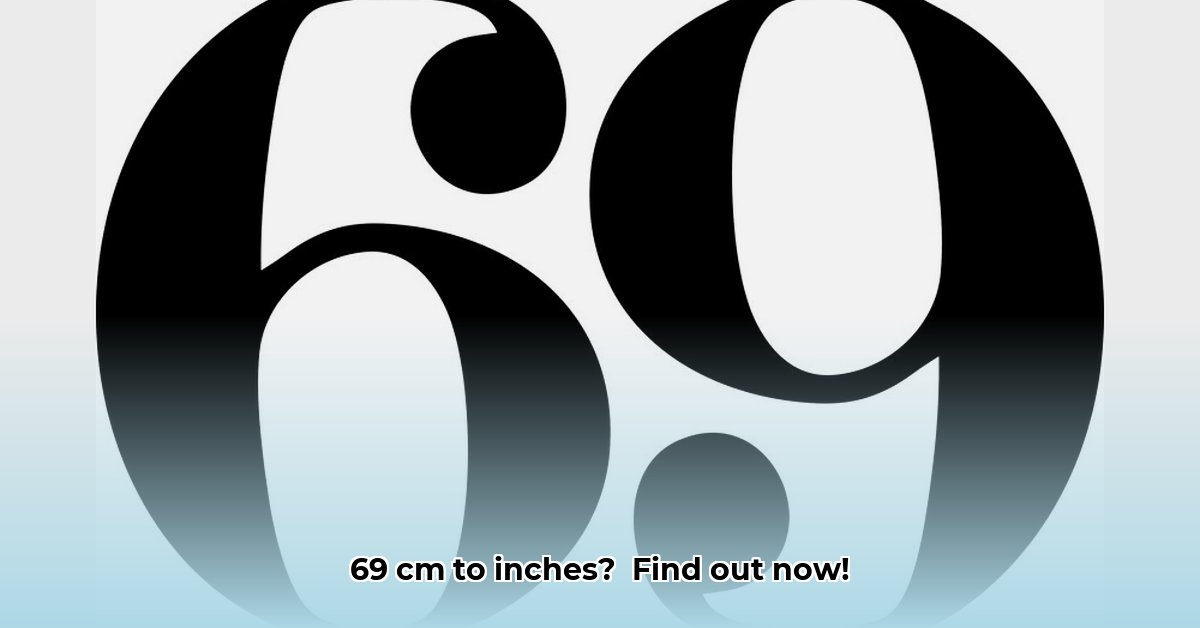Ever wondered how long 69 centimeters really is in inches? This comprehensive guide will show you exactly how to convert, regardless of your math skills. We’ll explore simple conversion methods, the history of these units, and the importance of accuracy. For more on unit conversions, check out this helpful guide on mile to kilometer conversions. By the end, you’ll be a centimeter-to-inch conversion expert, ready to tackle any measurement challenge!
Converting 69 cm to Inches: A Detailed Guide
Let’s explore how many inches are in 69 centimeters. Understanding the why behind the calculation can make it more intuitive.
A Brief History of Inches and Centimeters
Before diving into the math, let’s examine the origins of inches and centimeters. The inch is a unit within the imperial system, with a history stretching back to ancient civilizations. The centimeter is part of the metric system, a more modern and systematically organized system. The imperial system’s history is rich, with the inch’s definition evolving over time, originally linked to the length of barley grains! The modern inch is now precisely defined in relation to the metric system, facilitating accurate conversions between the two.
The Key: The Conversion Factor
The core of converting centimeters to inches is the conversion factor: 1 inch equals 2.54 centimeters. This constant ensures reliable and consistent conversions.
Method 1: The Direct Division Method
This approach uses the simple formula: inches = centimeters / 2.54.
Step 1: Start with your measurement in centimeters (69 cm).
Step 2: Divide by 2.54: 69 cm / 2.54 cm/inch = 27.16535 inches
This yields a very precise answer with multiple decimal places.
Method 2: Estimation Through Multiplication
For a quicker, albeit less precise, estimation, you can use the fact that 1 centimeter is approximately 0.3937 inches:
Step 1: Begin with your measurement in centimeters (69 cm).
Step 2: Multiply by 0.3937 inches/cm: 69 cm * 0.3937 inches/cm ≈ 27.1653 inches
This method provides a result similar to the division method. The slight difference highlights the effect of rounding.
Accuracy vs. Precision in Conversions
The distinction between these two methods underscores the importance of accuracy and precision in measurements. Accuracy refers to how close a measurement is to the true value. Precision relates to the consistency of repeated measurements. Both Methods 1 and 2 are accurate for converting centimeters to inches, utilizing established conversion factors. However, the desired level of precision depends on the specific application.
For everyday tasks, like measuring fabric or estimating furniture dimensions, a few decimal places are usually sufficient. You might round the answer to 27.17 inches. However, in fields like engineering or scientific research, where extreme accuracy is crucial, more decimal places might be necessary.
Precision Levels for Different Applications
The following table outlines the required precision for various scenarios:
| Application | Required Precision | Example |
|---|---|---|
| Everyday measurements | One or two decimal places | Measuring fabric for sewing |
| Carpentry | Two decimal places | Cutting wood accurately |
| Engineering | Multiple decimal places | Manufacturing precision components |
| Scientific Research | Very high precision (many decimal places) | Microscopic measurements, high-resolution imaging |
| CNC Machining | Up to four decimal places | Creating accurate parts from a digital design |
| Electronics Manufacturing | Two to three decimal places | Designing and producing circuit boards |
| Medical Device Manufacturing | Three to five decimal places | Ensuring precision in medical equipment |
Next time you convert centimeters to inches, consider this guide! Choose the method and precision level that best fits your needs. For simple tasks, don’t overthink it, but when high precision matters, use the appropriate tools and techniques.
Accurate Centimeter-to-Inch Conversions for Engineering
Key Takeaways:
- The conversion factor is 1 inch = 2.54 centimeters.
- Two methods exist: division (cm / 2.54) and multiplication (cm * 0.3937).
- Rounding impacts accuracy, especially in engineering and design.
- Online converter discrepancies stem from different rounding methods.
- These nuances are crucial for accurate engineering applications.
Let’s explore how to convert 69 centimeters to inches. Using the conversion factor: 1 inch = 2.54 centimeters (cm), you can divide centimeters by 2.54 to get inches, or multiply by 0.3937 (the inverse of 2.54). Both yield the same result.
Method 1: Conversion by Division
- Start: You have 69 cm.
- Apply the factor: Divide 69 cm by 2.54 cm/inch.
- Calculate: 69 cm / 2.54 cm/inch ≈ 27.165 inches.
Method 2: Conversion by Multiplication
- Start: Again, you have 69 cm.
- Apply the factor: Multiply 69 cm by 0.3937 inches/cm.
- Calculate: 69 cm * 0.3937 inches/cm ≈ 27.165 inches.
Both methods provide nearly identical results.
Precision in Engineering
In typical conversions, rounding to one decimal place (27.2 inches) might suffice. However, engineering needs far more precision, possibly fractions of an inch. Small rounding errors repeated in construction or manufacturing can lead to significant issues.
Proper Precision for Accuracy
The needed precision depends on the application. Building furniture allows rounding, but microchip creation demands greater precision.
Addressing Variations
Online converters show variations due to rounding. Some might round to the nearest hundredth, others to thousandths. Always consider the converter’s precision, especially when high accuracy is needed.
Converting Centimeters to Inches for Precise Measurements
Key Takeaways:
- Conversion factor 1 inch = 2.54 centimeters.
- Multiple conversion methods exist.
- Accuracy is vital in engineering; discrepancies impact manufacturing.
- Understanding rounding errors is essential.
- Method choice depends on needed precision.
Let’s discuss converting centimeters to inches for precise engineering measurements, focusing on 69 cm as an example to highlight potential issues.
Understanding Measurements
The relationship 1 inch equals 2.54 centimeters underpins crucial calculations. The inch evolved from barleycorn lengths to its standardized definition.
Method 1: Division
The straightforward approach uses: inches = centimeters / 2.54. For 69 cm: 69 cm / 2.54 cm/in ≈ 27.165 inches. But, what about more decimal places?
Method 2: Multiplication
An alternative uses the reciprocal of 2.54: inches = centimeters * 0.3937. This gives: 69 cm * 0.3937 ≈ 27.165 inches. Which method is more accurate?
Precision in Contexts
In everyday life, differences are minor. But for converting centimeters to inches for precise engineering measurements, small errors are significant. Imagine spacecraft or jet engine parts. Minute inaccuracies can be catastrophic. For most engineering applications you’ll probably only be dealing with a precision of two to four decimal places. It is important to use the correct number of decimal places as this is a key aspect of converting centimeters to inches for precise engineering measurements.
Precision for Units
Precision depends on the application. Woodworking allows rounding, precise machining demands accuracy. Tolerance, the range of acceptable variation, is key.
Addressing Discrepancies in Unit Conversions
Rounding differences may cause variations in online converters’ results. Consider the needed precision carefully and use the appropriate tools.















